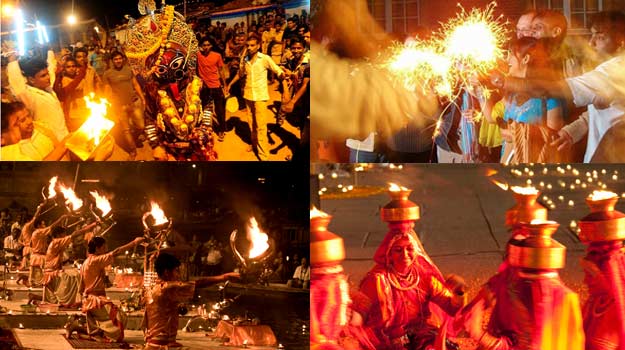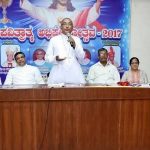How India Celebrates Diwali
Despite the nation-wide ban of sale and bursting firecrackers, the spirit of Diwali festivities and celebration will continue across the country. Called the festival of lights, the festival symbolizes the victory of good over evil! The entire country will be brightly lit, new accounts will be opened and new things will be brought to the house. In this part, each region has got its very own way of celebrating the festival.
Every Indian welcomes the divine festival of Diwali with open arms. Irrespective of different cultures and backgrounds, the nation comes together on this auspicious day. It is one of the popular Indian festivals of the year that is celebrated with lights, gifts, rangolis, joy, and laughter. Although the essence of the festival stays the same across the country, Diwali traditions and activities vary from state to state.
Diwali in South India
In the southern part of India, people celebrate the festival in the Tamil month of Aipasi (Thula month). It is also known as Naraka Chaturdashi among south Indians. On this day, they bathe in oil and eat sweets to commence the festival. Besides, they also celebrate a unique festival called Thalai Deepavali. During this day, newlyweds spend time at the bride’s parental house.
Diwali in Karnataka
In Karnataka, they celebrate two essential days, Ashwija Krishna Chaturdashi and Bali Padyami. On Ashwija Krishna Chaturdashi, people bathe in oil. On Bali Padyami, they narrate the stories of King Bali and create forts made from cow dung.
Diwali in Tamil Nadu
On the auspicious day of Diwali, Tamilians wake up at the crack of dawn to bathe in oil infused with betel leaves, fragrant pepper, and so forth. After their bath, they consume a tonic, Deepavali Lehiyam before their feast.
Diwali or what is known as Deepawali down south is celebrated a day earlier. Puzzled? Well, what northern India celebrates as Chhoti Diwali (Narak Chaturdashi) is the main day of the festival for the southern part of the country. In Tamil Nadu, the day begins with an oil bath before sunrise. Tamilians light the kuthu vilaku (lamp) and offer neivedyam to deities. They also prepare an ayurvedic medicine called lehyam for all indigestion that follows after you gorge on the succulent sweets over the five days of festive fervor. Well, even the north can learn a lesson here. Because let’s be honest, we know what tons of Kaju katli can do to your stomach!
Diwali in Andhra Pradesh
Every Diwali, people of Andhra Pradesh chant prayers and seek blessings from the clay idol, Satyabhama. Post that, they begin celebrating Diwali with their loved ones with excitement.
In Andhra Pradesh, on Diwali people celebrate the victory of lord Sathyabama over the demon Narakasura. The other aspects of the celebration are similar to the rest of the country wherein people don new clothes and welcome the festival of wealth and prosperity.
Diwali in Eastern India
In Eastern India, many believe that keeping their doors open on the occasion of Diwali will allow the entry of Goddess Lakshmi in their house. So, every individual lights their whole house with diyas and lamps.
Diwali in Bengal
In Bengal, Diwali is celebrated as Kali Puja. On this day, people offer Goddess Kali with fish, meat, hibiscus flowers, and so on. Usually, Kali Puja takes place overnight in several pandals. It is a grand celebration at Kalighat and Dakshineshwar temple in Kolkata.
In West Bengal, Diwali coincides with Kali Puja and is one of the biggest festivals in the country. You can find houses decked up with lamps and people thronging famous temples like Kali Temple in Kalighat and Dakshineshwar to offer their prayers. You can also do a pandal hopping in Kolkata as there are several Kali puja Pandals that are set up across the city.
Diwali in Odisha
The people of Odisha worship the ancestors in heaven on the auspicious festival of Diwali. They burn jute sticks to seek blessings and receive luck on this day.
Diwali in Western India
Western India celebrates Diwali in a grand way every year. A few days ahead of the festival, the markets in this region are flocked with several diyas, lamps, firecrackers, and so on to kick start the Diwali celebrations.
Diwali in Maharashtra
The festivities last generally last between 4-5 days. The Hindus of the state follow different Diwali traditions for each day. On this day, the traditional Diwali food remains ‘Faral’ popularly called by Maharashtrians.
Diwali celebrations in Maharashtra begins with Vasu Baras. Here Dhanteras is celebrated in the form of dhantrayodashi, while Chhoti Diwali takes the form of Narak Chaturdashi. On the day of the festival, Maharashtrians pray to goddess Laxmi and also observe Diwali cha padva which celebrates the bond of marriage. The festivities come to an end with Bhaav Bij and they welcome the wedding season with Tulsi Vivah.
Diwali in Gujarat
The hub of trade and business, Gujarat celebrates Dhanteras on a grand scale. In many households, women apply kajal made from the flames of the diyas to bring in some fortune and prosperity.
For Gujaratis, Diwali marks the end of the year. Also for the business-oriented West, Diwali always means Laxmi pooja. It’s a common belief in western India that the ‘goddess of wealth’ pays a visit to your house on this auspicious day, so you can find Gujaratis prepping for the occasion at least 15 days in advance. The markets are bustling with shoppers and intricate rangolis is made outside houses. One can even find tiny footsteps drawn outside individual doorsteps as a way of welcoming the goddess.
Diwali in North India
North Indians believe the popular legend of the return of Lord Rama from his exile to Ayodhya. To welcome the homecoming of Lord Rama along with his wife, Sita, and brother, Laxman, everybody lights the house with rows of diyas.
Diwali in Punjab
The celebrations of the festive season mark the arrival of winters. In Punjab, Sikhs celebrate the festival at gurudwaras, while Punjab Hindus worship Goddess Lakshmi on this day.
In Punjab, Diwali marks the advent of the winters. The farmers start preparing for the farming season and sow the first batch of seeds. While Sikhs do not celebrate the festival as such, they celebrate Bandi Chhor Diwas that falls on the same day. The festival commemorates the day of liberation. The golden temple is lit up with thousands of earthen lamps and fireworks and langar is set up for those who come to offer their prayers at the sacred site.
Must Read:Ramayana Trail across the World – Chinese Ramayana
Diwali in Uttar Pradesh
Every year, the people of Uttar Pradesh celebrate the festival with great enthusiasm. The celebrations take place at large in Varanasi at the banks of the holy river, Ganga. It is lit with earthen lamps that float over the surface, while the priests chant prayers at the banks.
Diwali in the state of Uttar Pradesh is a treat to the eyes. Believed to be the birthplace of Lord Rama, the festival of lights is an extravagant affair here. The festivity begins with the grand Ganga aarti in the evening. Thousands of illuminated lamps (diyas) float over the surface of the river Ganges. As the night progresses, one can witness the enchanting sight of thousands of priests chanting hymns and bringing in the festive feels. The experience is as mesmerizing as it is spiritual.
[video_ads]
[video_ads2]
You can send your stories/happenings here:info@religionworld.in









